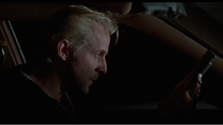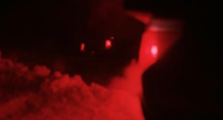220 | nº 31, pp. 207-238 | doxa.comunicación
July-December of 2020
Study on the cinematographic image composition: frame, light, and colour as expressive elements...
ISSN: 1696-019X / e-ISSN: 2386-3978
3.1.3. Lighting
In Fargo, this variable has a functional nature that provides realism to outdoor locations, landscapes where the light is mainly natural. In this way, the only intentionality observed is to make the story credible. However, one exception is when the police officer is killed, and the chase takes place, mentioned in the previous section. In this scene, the lighting becomes the protagonist, and we observe an intentional use of spotlights, which are reflected in the two kidnappers’ eyes. First use: the reflection of the light from the police car’s headlights after the officer’s death shows Carl’s blood-spattered face. The purpose of spotlighting, in this case, is to focus the shot on his expression of horror after the event, increasing the drama in the scene (figure 6). Second use: during the car chase, this same type of lighting is used to show Gaear. Now, the light is focused again on this character’s gaze; it is focused on the highway and the car he is following to see the character’s behaviour and/or actions, his anger, and the absence of emotions (figure 7).
Seconds later, when Gaear is about to pull the trigger to kill one of the witnesses, the car’s backlight is reflected on him, and the red coloured gun reinforces the notion of rage (figure 8).

Source: Fotograma Fargo
Source: Fotograma Fargo
Figure 6: Image expression of horror
Figure 7: Lighting showing gaze

Source: Fotograma Fargo
Figure 5. Image tinted in red